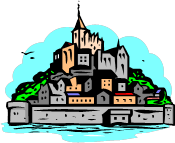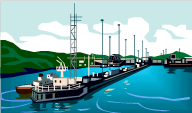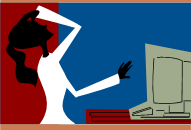Archive for the ‘Finland’ Category
A Story Without an End
 Every year for Christmas I write a bit about some ancestor I have studied over the year. Of course this year I will choose Finns because I have worked on that line this year, even traveling to Finland.
Every year for Christmas I write a bit about some ancestor I have studied over the year. Of course this year I will choose Finns because I have worked on that line this year, even traveling to Finland.
I have in mind to write biographical sketches of my four Finnish great-great grandparents, but I am facing a problem with this. I cannot complete their stories.
As far as l know, these people, Antti Mattila, Elisabeth Myllynen, Matti Lampinen, and Anna Miettinen, remained in Finland throughout their lives. I must use the Finnish records to do the research on them.
For reasons unknown to me, the available online records end with the 1880’s. Only Anders Mattila had died by then, in 1882. The others passed away after that, but those records remain closed to me. I hate this loose end, but what can I do?
No family records kept this information, and no one else’s online family tree provides a clue.
I do have one other less-than-ideal option. The LDS library does have rarely-used microfiche copies of the Finnish Communion books. These books listed Finnish families and tracked which confirmed Lutherans took communion over the course of several years. A death during the time period was so noted. I could look there.
The LDS digitization project has not gone this far, so I must look at the actual microfiche to see if I can find the information I need. To do this, I could either rent the fiche for viewing at my local Family History Library or travel to Salt Lake to view them there.
I cannot take a trip to Salt Lake this fall. For now, I will add this source to my white board list of records to search. I will have to do some additional research before I can identify just which parish microfiche to order.
Christmas is coming, and I would like to finish my stories.
Lulu and Bubber
 My mom grew up in Hibbing, Minnesota where her Finnish Mattila family surrounded her with grandparents, aunts, uncles and cousins. She moved away from there when she grew up, but over the years she and my grandmother talked about these relatives a lot. Consequently their names became familiar to me although I never met most of them.
My mom grew up in Hibbing, Minnesota where her Finnish Mattila family surrounded her with grandparents, aunts, uncles and cousins. She moved away from there when she grew up, but over the years she and my grandmother talked about these relatives a lot. Consequently their names became familiar to me although I never met most of them.
The other day I came across an undated photograph of a family gathering in Hibbing, probably from the 1940’s. I recognized a few of the people but could not identify all of them. Luckily, someone had thought to write names on the back of the picture. They included two children named Lulu and Bubber. Odd names that must have been nicknames. Who were they?
I vaguely recalled hearing these names before, but I could not remember these kids’ real names or how they were related to me. This week I figured it out.
When I visited the Minnesota Historical Society last month, I gathered several death certificates for my Finnish family. One of them was for my great-great aunt, Anna Mattila Anderson (abt. 1866-1947). As I pieced together her life, I looked at her household on the 1940 U.S. census.
This evidence solved my mystery. The record listed two grandchildren for Anna, Louise and Charles. Lulu and Bubber, my mom’s second cousins!
A Genealogy Summer
 We filled our summer this year with several trips, and on each one we collected genealogical information. Now we must sort and analyze all of it. We keep copies of the documents and photos–paper for me and digital ones for my husband/tech advisor. We will put the data into our genealogical software, The Master Genealogist, over this month. Then we will upload the new information into the family trees on our website.
We filled our summer this year with several trips, and on each one we collected genealogical information. Now we must sort and analyze all of it. We keep copies of the documents and photos–paper for me and digital ones for my husband/tech advisor. We will put the data into our genealogical software, The Master Genealogist, over this month. Then we will upload the new information into the family trees on our website.
Here is where we went and what we brought home:
- Virginia. This was a sad trip for my 25-year-old nephew Tyler William Reed’s funeral. We brought home documentation of his death.
- Finland and Russia. The church records for my Finnish family are available online, so we did not visit any repositories to collect documents in country. Instead, we picked up Finnish history information at the National Museum (http://www.nba.fi/en/nationalmuseum), and we took photos of all the places in Finland and Russia where we knew my family lived. We did not visit cemeteries because graves in Finland are reused after a generation. There are none for my family members, most of whom immigrated around 1905.
- Minnesota. We tracked my husband/tech advisor’s family across the state, taking photos at many cemeteries. In addition to putting this information on our website, we will create memorials on Find A Grave (http://www.findagrave.com/). In Minnesota we also visited the Great River Regional Library in St. Cloud (http://www.griver.org/) and the state’s Historical Society Library in St. Paul (http://sites.mnhs.org/library/). There we snagged death certificates and obituaries for both our families. Our big find, though, was the name of our Walz ancestors’ village in Bavaria (Ratzstadt, Underfranken). The information turned up in a Stearns County history, in a biographical sketch for a collateral relative.
- Wisconsin. This was another family occasion, and we returned with information on my niece’s marriage.
We had a productive summer of research. Processing and following up on all the information we gathered should keep us busy until our next trip—to Virginia again next summer for a wedding.
A Family for Rosie
 Last week I wrote about the fate of my grandmother’s relative, Rosie Poraas. Grandma thought poor Rosie had frozen to death in a Hibbing snowbank, but I learned that she actually died from pneumonia.
Last week I wrote about the fate of my grandmother’s relative, Rosie Poraas. Grandma thought poor Rosie had frozen to death in a Hibbing snowbank, but I learned that she actually died from pneumonia.
Grandma often mentioned several of her relatives, including Rosie. As a youngster I never paid much attention to the relationships of these people to Grandma or to myself. When I began researching my family history in earnest, Grandma was gone, and my mom was vague on some of the details.
So my question became “How was Rosie related to Grandma and to me?” I began with this information:
- Grandma’s parents, Ada and Alex Mattila, emigrated from Vyborg, Finland. Grandma told me that none of Ada’s family came over to the U.S., so I reasoned Rosie must have been a Mattila relative.
- Three of Alex’s seven or eight sisters, Anna Anderson, Olga Silberg, and a third who lived in Biwabik, MN emigrated to the United States.
- Poraas was Rosie’s married name.
Perhaps Rosie was a sister or niece of Alex. Research in Finland parish records did not locate any sister named Rose. Her birth years on U.S. census records indicated that she was more likely a niece. So was one of Alex’s sisters the mother of Rosie?
I could eliminate both Anna and Olga as candidates. My mom knew these women, and she knew their children, her mother’s cousins. Rosie was not one of them.
So what about the aunt in Biwabik? After much research, I learned that her name was Ida Marie Mattila Mattson Parks, and she died in 1917. Did she have a daughter named Rosie?
The Mattson family’s ship passenger list states that Ida traveled to America with children Elsa, Yrgo, and Martha. The record also has a tantalizing note about an unnamed 17-year-old daughter. Rosie?
U.S. census records reveal that the older daughter was named Alice, not Rosie. Furthermore, the Finnish parish records list only Alice, Elsa, Yrgo, and Martha as children for Ida Marie. If she was not Rosie’s mother, who was?
Still hypothesizing that Rose was Alex’s niece, I returned to the Finland parish records to identify the children of Alex’s surviving sisters remaining in Finland—Karolina Mattila, Eva Emilia Mattila, and Sophia Mattila (Mrs. Karl Ripatti. This time I found a birth record for a daughter, Rosa Wilhelmina, born to Sophia Mattila in Vyborg on 30 Aug 1896. Perhaps this Rosa Wilhelmina was Rosie Poraas.
The proof came when I searched for Rosie’s death certificate at the Minnesota Historical Society Library earlier this month. It listed her parents as Sophia Mattila and Carl Ripotti of Vyborg, Finland. At last, a family for Rosie. She and Grandma were first cousins; their parents were sister and brother.
What Happened to Rosie Poraas?
 My Finnish grandmother liked to gossip. Whenever she visited, we received the low-down on all the relatives, dead or alive. She even knew what kind of breakfast food everyone ate.
My Finnish grandmother liked to gossip. Whenever she visited, we received the low-down on all the relatives, dead or alive. She even knew what kind of breakfast food everyone ate.
When she came to visit, I eagerly listened to all these family stories. I was probably a budding genealogist even then.
The story that always stuck in my mind was the tale of Grandma’s cousin, Rosie Poraas. “She froze to death in a snowbank!” my grandma would exclaim dramatically. Could this be true?
Last week I had a chance to find out when I visited the Minnesota Historical Society Library. They have Minnesota death certificates on microfilm.
I pulled up the record for Rose Poraas who died in Hibbing, Minnesota in February, 1941. She died of pneumonia. The record says she had been ill for nine days. She did not freeze to death in a snowbank.
Still, as for most family stories, I think there is a kernel of truth in what my grandmother said. Rosie probably became ill and collapsed into the snow during the Minnesota winter. After being found, she lived nine days before finally succumbing to her illness. The story had the same sad outcome, but Grandma had a few of the facts wrong.
Rosie’s story was not the only one we completed during our visit to the Library. This repository also holds historical Minnesota newspapers, many on microfilm. We spent an entire day there and fleshed out the family trees for several of our ancestors. But no one else’s fate could compare to Rosie’s. Now I can set her record straight.
A Lampinen Family Takes Shape
 Finally, I have a family for my great-grandmother, Ada Alina Lampinen (1879-1948).
Finally, I have a family for my great-grandmother, Ada Alina Lampinen (1879-1948).
In May I wrote that I had embarked on a search for the names of her siblings. I began combing the Finnish church records for Juuka parish to find them.
The first two names, Henric (1857) and Anna Valborg (1859), came easily because I could use an online index. The next set of Juuka birth and baptism records (1860-1879) has no online index so I needed to browse these records.
After working through the summer, I have now finally finished this somewhat tedious work. It involves deciphering pen-and-ink lettering done in an old-style cursive. I read through the entries for every year looking for the names of Ada’s parents Matti Lampinen and Anna Miettinen as they presented another child to the parish pastor for baptism. I came up with quite a list:
- Henric (1857)
- Anna Valborg (1859)
- Eva Stiina (1861)
- Hendrika (1862)
- Matts (1864)
- Alexander (1866)
- Adam (1868)
- Alexis (1868)
- Mathias Alexander (1870)
- Lovisa (1873)
- Anders (1876)
- Ada Alina (1879)
If you look closely at this large family you will see that we have two children born in 1868, Adam and Alexis. Strangely, these boys were not twins. The record shows one born in April of that year and the other born just four months later in August. This seems very odd. I need to find some more records on these boys to see if I can find an explanation.
In fact, I need to find more records on all of these people. The list raises other interesting questions. Why do we have children with such similar sounding names as Henric and Hendrika? Could she have been named after him because he passed away? Similarly, the name Alexander appears twice. Did the older boy die young?
I plan to move on to the Juuka death records for more information. I need death dates for all these people anyway, and perhaps they can explain some of the curiosities in my list.
A Journey Through Ancestral Lands in Finland and Russia
Every genealogist wants to walk the land of his ancestors. That’s why I went to Finland and Russia. There I did some walking, and my husband/tech advisor did a lot of driving. Our trip included three very different segments.
First Leg
 Flying on Icelandair, we landed in the capital city of Helsinki and stayed a couple of days. This allowed us to get over any jet lag and learn a little about modern Finnish culture. By staying in a downtown hotel we could walk everywhere we wanted to go. The iconic Finnish department store, Stockmann’s, lay just across the street. I looked at the famous Iitala glassware there but did not purchase any.
Flying on Icelandair, we landed in the capital city of Helsinki and stayed a couple of days. This allowed us to get over any jet lag and learn a little about modern Finnish culture. By staying in a downtown hotel we could walk everywhere we wanted to go. The iconic Finnish department store, Stockmann’s, lay just across the street. I looked at the famous Iitala glassware there but did not purchase any.
The morning after our arrival we walked to see the famous Church of the Rock (Temppeliaukio) and then went on to the National Museum of Finland (http://www.nba.fi/en/nationalmuseum). We viewed their exhibits of artifacts arranged in chronological order from prehistoric times until today. I found the 19th-century throne room just astounding. It includes a real red velvet and gilt throne and luminous portraits of every Russian czar and czarina who ruled over the Duchy of Finland (1809-1917). My grandmother’s family emigrated to America during the Duchy period.
Second Leg
 Leaving Helsinki, we picked up a rental car for the next part of our trip. As we drove along modern highways through endless forests we soon learned that rural Finland is very sparsely populated. Northeast of Helsinki we traveled past the farms where my Mattila and Miettinen families had lived. At the end of the day we reached the Koli National Park (http://www.luontoon.fi/retkikohteet/kansallispuistot/koli/Sivut/Default.aspx) in the North Karelia region of Finland. All I can say is, “Wow”. No wonder this beautiful area provided inspiration for great Finnish artists and composers.
Leaving Helsinki, we picked up a rental car for the next part of our trip. As we drove along modern highways through endless forests we soon learned that rural Finland is very sparsely populated. Northeast of Helsinki we traveled past the farms where my Mattila and Miettinen families had lived. At the end of the day we reached the Koli National Park (http://www.luontoon.fi/retkikohteet/kansallispuistot/koli/Sivut/Default.aspx) in the North Karelia region of Finland. All I can say is, “Wow”. No wonder this beautiful area provided inspiration for great Finnish artists and composers.
The Koli resort has a commanding view of thick forests and the gorgeous Lake Pielinen, the fourth largest of the nearly 200,000 lakes in Finland. We stayed two nights, drinking in the view, eating authentic Karelian meals (my comfort food!), and visiting the sauna.
In the morning, we hiked through the forest over to the nearby restored Mattila barn (not my Mattila family). The trail has interpretive signs in Finnish and English telling about the historic settlements in the area. My Lampinen family lived on the farms surrounding Lake Pielinen, so I eagerly learned all about the slash and burn agriculture that probably provided the livelihood for my ancestors. Later we drove around the lake to see the various settlements where my people had lived. They all lie in the Juuka parish of the Evangelical Lutheran Church of Finland, and we stopped in to see this church.
Third Leg
From Koli we drove to the southeastern city of Lappeenranta on Lake Saimaa. Early the next morning, as in really early at 7:00 a.m., we embarked on a river boat tour through the Saimaa Canal to the Baltic port city of Vyborg, Russia. I felt more than a little apprehensive. We were the only Americans on the boat.
My fears proved groundless, and these 5-hour boat rides to and from Vyborg became a highlight of my trip. I had wonderful conversations with my fellow passengers, and we enjoyed tasty lunches in the dining room. A Finnish singer provided entertainment using a songbook he distributed to everyone. Everyone knew all his songs, and with the words provided even I could participate a little.

In Vyborg, the tour company helped us through Customs and took us to our hotel. On the bus, we had our first glimpse of a Russian city. It seemed as if time had stopped in 1947. That year, in an agreement to settle the damages of World War II, Finland had ceded 12% of its territory to the Soviet Union. The cession included the ancient Finnish port city of Viipuri. The town became known as Vyborg, and nearly all the Finns walked out to be resettled in the Karelian area of Finland. Today, Vyborg is populated with Russians, not Finns. Virtually no one there speaks any English.
My great-grandparents, Alex Mattila and Ada Lampinen, married in Viipuri in 1904. I wanted to see the city even though few Finns remain there. Armed with an approximate address for where the couple had lived, we walked from our hotel to find the neighborhood. It is the same neighborhood where Vladimir Lenin lived a few years later to plot the Russian Revolution. On the way there, we passed small shops and parks; Vyborg is very pedestrian-friendly. I could imagine my great-grandparents walking these same streets. Unfortunately, we could not visit the church where they were married because it was destroyed in the war.
After visiting that area, we walked to the famous Vyborg Castle, first built by the Swedes in the 1200’s. We climbed to the top where I could look out the narrow windows into the distance to where my Mattila and Myllynen families had lived in the rural around Viipuri. The price of admission to the castle included a visit to the museum filled with photos of Viipuri from the time my family lived there.
Home Again
From Vyborg we boarded the canal boat and returned to Lappeenranta to pick up our rental car. On the way back to Helsinki, we took the route through Kotka. After my great-great grandfather Anders Mattila died, my widowed great-great grandmother Elizabeth Myllynen relocated there from the Viipuri area. We drove past the property where she had lived.
Then we were off to Helsinki to board our plane home. I hated to leave this beautiful country of lakes and forests. But even as I left, I knew that now I have pictures of where my ancestors lived in my head. I have a better knowledge of the geography of their surroundings and of their way of life. I am so glad I went.

What a Trip!
 We just returned from our summer research trip to Finland and Russia.
We just returned from our summer research trip to Finland and Russia.
I admit I felt a little apprehensive before I traveled there. I know nothing of the languages spoken in those countries and we did not go over with a tour group. Because neither Finnish nor Russian comes from Germanic roots, and Russians even use a different alphabet, I knew I would have no hope of deciphering signs, menus, etc.
Turns out we had no problem. Nearly everyone in Finland speaks some English, and in Russia they had menus with photos of each dish. Usually we could point at what we needed. Aside from my husband’s hilarious attempt to locate a water closet at Vyborg Castle, everything went very smoothly.
My direct maternal line comes from Finland, and I felt right at home there. These people are my people. I recognized the foods, the faces, the ways of doing things. I felt their sadness at the loss of their beautiful city, Viipuri (now Vyborg, Russia). I really found my roots on this trip.
Oh, For a Finnish Gazeteer
 Sometimes I wonder why I even try to do genealogical research in foreign records when I do not have the proper tools. Well, the answer is that I cannot find the proper tools. I want to find my ancestors, though, so I continue anyway.
Sometimes I wonder why I even try to do genealogical research in foreign records when I do not have the proper tools. Well, the answer is that I cannot find the proper tools. I want to find my ancestors, though, so I continue anyway.
This year I ran into the same problem with Finnish research that I had last year with Norwegian research. Both countries have fabulous church records available online, but of course they are all kept by parish. So how do you find the parish boundaries? And how do you know the name of the political jurisdiction associated with the parish at any given time?
None of the maps I have located show both parish outlines and political boundaries. It seems you can have just one or the other. I know these lines changed over time. How am I supposed to even fill in a Family Group Sheet when I cannot figure out the municipality or sub-region associated with a particular church? I find it maddening.
I have searched the local libraries and the internet in vain for any help. So I slog on, but I know my location entries are riddled with errors. This week I needed the correct political jurisdiction for Finland’s Juuka parish for 1860-1879. Karelia? If so, was it East, North, or South? So far I have been unable to discern this information. I sure envy those German researchers with their wonderful gazetteers that tell all.
A Family for Ada Lampinen
“We knew nothing of our mother’s family. They all stayed in Finland.” This was the only information my grandmother could offer when I asked her about my great-grandmother Ada Alina Lampinen’s family. How do you build a birth family with so little to go on?
In genealogy we work backwards in time, so I began looking for data on Ada herself. My mother told me she had died in Hibbing, Minnesota on the twelfth of May, 1948. Mom also knew she had been 27 years old when my grandmother was born in Minnesota in 1906, suggesting that Ada was born in 1879. Lastly, Mom also recalled her grandfather saying the family was from Viipuri. Another daughter kindly visited the genealogy library at Iron World in Chisholm, Minnesota and found the family’s 1905 immigration papers.
Thus armed with a time frame and an approximate location, we began our search for the Lampinens in the Finnish records. Here is where my husband/tech advisor came in handy.
He located Finnish newspapers online (http://digi.lib.helsinki.fi/index.html) and found a 1904 marriage announcement for Alex and Ada (Lampinen) Mattila in Viipuri. This confirmed our location, and began our dive into Finnish parish records.
These records can be found online, too, at Finland’s Family History Association (http://www.sukuhistoria.fi/sshy/index_eng.htm). Luckily, the index offers a country-wide search, because we found no birth record for Ada in Viipuri parish. Using the broader search, we finally located an 1879 birth and baptism record for Ada in Juuka parish. We learned that her parents were Matti Lampinen and Anna Miettinen who married in 1856. So what about the rest of her family?
The Juuka parish registers for many of the years in which the Lampinen children would have been born have not been indexed. Now I am searching the Juuka images page by page to find them. In addition to Henric (b. 1857) and Anna Valborg (b.1859), this week I located the birth and baptism record for Eva Stiina (b. 1861). I still have 18 years of records to search before reaching Ada’s own birth record in 1879.
Although this is a slow process, I am eager to learn how many sibilings Ada had. Soon we will no longer be saying that we know nothing of her family.